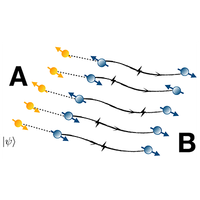Quantum Criticality Under Imperfect Teleportation
引用次数: 0
Abstract
Entanglement, measurement, and classical communication together enable teleportation of quantum states between distant parties, in principle, with perfect fidelity. To what extent do correlations and entanglement of a many-body wave function transfer under imperfect teleportation protocols? We address this question for the case of an imperfectly teleported quantum critical wave function, focusing on the ground state of a critical Ising chain. We demonstrate that imperfections, e.g., in the entangling gate adopted for a given protocol, effectively manifest as weak measurements acting on the otherwise pristinely teleported critical state. Armed with this perspective, we leverage and further develop the theory of measurement-altered quantum criticality to quantify the resilience of critical-state teleportation. We identify classes of teleportation protocols for which imperfection (i) preserves both the universal long-range entanglement and correlations of the original quantum critical state, (ii) weakly modifies these quantities away from their universal values, and (iii) obliterates long-range entanglement altogether while preserving power-law correlations, albeit with a new set of exponents. We also show that mixed states describing the average over a series of sequential imperfect teleportation events retain pristine power-law correlations due to a “built-in” decoding algorithm, though their entanglement structure measured by the negativity depends on errors similarly to individual protocol runs. These results may allow one to design teleportation protocols that optimize against errors—highlighting a potential practical application of measurement-altered criticality.

不完全远距传输下的量子临界性
纠缠、测量和经典通信共同实现了量子态在遥远双方之间的远距离传输,原则上完全保密。在不完美的远距传输协议下,多体波函数的相关性和纠缠性会在多大程度上发生转移?我们以临界伊辛链的基态为重点,探讨了不完全远距传输的量子临界波函数的这一问题。我们证明,不完美(例如特定协议采用的纠缠门)会有效地表现为作用于原本纯净的远距传输临界状态的弱测量。从这个角度出发,我们利用并进一步发展了测量改变量子临界性理论,以量化临界状态远距传输的弹性。我们确定了几类远距传输协议,对于这些协议,不完善性(i)保留了原始量子临界状态的普遍长程纠缠和相关性,(ii)弱地改变了这些量,使其偏离了普遍值,(iii)在保留幂律相关性的同时完全抹去了长程纠缠,尽管有一组新的指数。我们还证明,由于采用了 "内置 "解码算法,描述一系列连续不完美远距传输事件平均值的混合态保留了原始的幂律相关性,尽管它们的纠缠结构由负率衡量,与单个协议运行类似,取决于误差。这些结果也许能让我们设计出针对误差进行优化的远距传输协议--突出了测量改变临界性的潜在实际应用。
本文章由计算机程序翻译,如有差异,请以英文原文为准。
求助全文
约1分钟内获得全文
求助全文

 求助内容:
求助内容: 应助结果提醒方式:
应助结果提醒方式:


